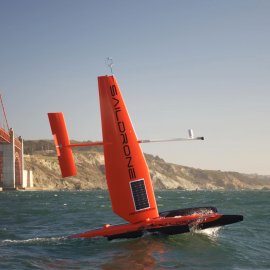Sail Drones: An Emerging Ocean Technology
-
English
-
ListenPause
Welcome to World Ocean Radio… I’m Peter Neill, Director of the World Ocean Observatory. Technology over the past decades has been driven in large part by exploration of space. Rockets, orbiting stations, and satellites seemingly as prevalent as stars are common to our experience and don’t surprise much anymore. Pictures of Mars might grab our attention, and photographs of mighty storms coming ashore to wreak anonymous devastation do catch the eye, but we’ve grown blasé and, with our ever shortening attention span, cast about for new unknowns to know, new amazement to discover, and so we turn to the ocean about which, the cliché asserts, we know less about that we know of the moon. The ocean is, without doubt, a place of endless fascination. BBC Television is currently broadcasting Blue Planet II, an astonishing compendium of underwater filming of ocean creatures. The technology continues to expand and suddenly we know more and more about the ocean. The scientists will tell us that there is never enough data to conclude, but it is not for lack of trying. We know have a Global Ocean Observation System [GOOS], “a means to guide the ocean observing community as a whole to establish an integrated and sustained global observing system - one that includes ocean physics, biogeochemistry, and ocean biology and ecosystems, and addresses the variables to be measured, the approach to measuring them, and how their data and products will be managed and made widely available to modeling efforts and a wide range of users” If you look at a map of the number of observation stations and instruments, fixed and floating throughout the ocean today, the number appears comparable to similar visualizations of the number of ships at sea. It is a complicated, inter-governmental, inter-agency research collaboration costing millions, justified as a first step toward mapping the ocean, understanding how it works, and learning what inhabits there from the surface to the underwater mountain ridges to the anomalies hidden in the darkness of the abyssal plain. A new technology has caught my eye. Sail Drones, a new programmable moving platform, an inexpensive mobile platform, powered by wind that can provide cost effective data collection over large ocean areas, mitigating the cost of very expensive ship time, easily recoverable, delivering real time data to a portal that can be accessed by any computer or smart phone any where. The drone can be modified with custom sensors, operated remotely, steered to avoid extreme weather and collision, re-programmed at sea, to gather complicated, changing information on climate conditions, to monitor fish migration and management, and to study health hazards such has pollution events, acidification concentrations, and migration of hazardous chemicals over large ocean areas. The drones can do more than any fixed or floating buoy, is simpler to build, install, and maintain, and represents a major increase in productivity at a major reduction of expense. More than half of the older technology monitors are broken or obsolete, so the drones arrive at a moment the research community is looking for greater capacity, enhanced flexibility, and significantly lower cost. This latter is a key. With government funds dramatically reduced, the availability to finance fixed monitors, build and operate submersibles, and avoid expense of supporting research vessels, at literally thousands of dollars per day, is simply unaffordable. The drones are manufactured, installed, and operated by SAILDRONE, based in Alameda, California, and has already performed over 60,000 miles of open ocean research expeditions in the Gulf of Mexico, the Bering Sea, and the Atlantic. The drones were first launched in 2013, with a proof of concept voyage in cooperation with NOAA, and in 2016 the company received $14 million in venture funding to expand the fleet and meet demand for future operations. Science opens our world by measuring and recording things. Sail drones and comparable technology is about measuring for the benefit of the scientific community; the BBC is about visualizing and engaging the public. The great oceanographer, Jacques Cousteau is famously quoted, “The future is in the hands of those who explore…and from all the beauty they discover while crossing perpetually receding frontiers, they develop for nature and for humankind an infinite love.” And then he concluded, “People protect what they love.” We will discuss these issues, and more, in future editions of World Ocean Radio. - - - [Outro music]
Ocean technologies and exploration are expanding at a remarkable pace, giving scientists and casual observers more data by which to learn more about ocean systems, fish migrations, fisheries management, physics, biochemistry, weather, climate, ecosystems, and much more. In this week's episode of World Ocean Radio host Peter Neill examines sail drones, an emerging technology that offers ocean data collection that is flexible, cost effective, easily recoverable, easy to maintain, and re-programmable at sea.
About World Ocean Radio
Peter Neill, Director of the World Ocean Observatory and host of World Ocean Radio, provides coverage of a broad spectrum of ocean issues from science and education to advocacy and exemplary projects. World Ocean Radio, a project of the World Ocean Observatory, is a weekly series of five-minute audio essays available for syndicated use at no cost by college and community radio stations worldwide.
If you value World Ocean Radio, please consider becoming a Patreon Supporter today.
Image Credit
SAILDRONE
< SailDrone: Ocean Data Redefined
< Global Ocean Observation System (GOOS)
- Login to post comments



